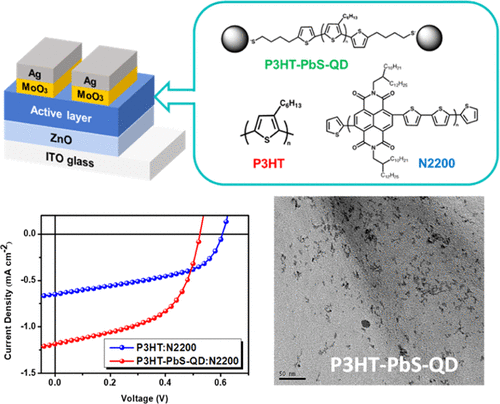当前位置:
X-MOL 学术
›
ACS Appl. Polym. Mater.
›
论文详情
Our official English website, www.x-mol.net, welcomes your feedback! (Note: you will need to create a separate account there.)
Thiol-end-functionalized Regioregular Poly(3-hexylthiophene) for PbS Quantum Dot Dispersions
ACS Applied Polymer Materials ( IF 5 ) Pub Date : 2021-08-09 , DOI: 10.1021/acsapm.1c00436 Keita Yoshida, Jia-Fu Chang, Chu-Chen Chueh, Tomoya Higashihara
ACS Applied Polymer Materials ( IF 5 ) Pub Date : 2021-08-09 , DOI: 10.1021/acsapm.1c00436 Keita Yoshida, Jia-Fu Chang, Chu-Chen Chueh, Tomoya Higashihara

|
Inorganic nanoparticles hybridized with π-conjugated polymers were successfully synthesized by the ligand exchange reaction of thiol-end-functionalized regioregular poly(3-hexylthiophene) (P3HT-SH) with lead sulfide (PbS) quantum dots (QDs). The hybrid material (P3HT-SH/PbS-QD) shows good dispersibility in organic solvents even after 6 months due to the decreased intermolecular interaction of PbS nanoparticles coated by highly soluble P3HT. The ultraviolet–visible–near infrared absorption spectra show a clear difference in PbS-QDs hybridized with oleic acid and P3HT-SH, depending on the size of the PbS-QDs. By using transmission electron microscopy, small clusters of PbS-QDs are observed at the nanolevel when hybridized with P3HT-SH, indicating the formation of nanoscale aggregates of PbS-QDs in the hybrid material. Preliminary results for fullerene-free photovoltaic applications showed that P3HT-SH/PbS-QD can deliver almost two times higher power conversion efficiency (PCE) than P3HT when paired with an n-type naphthalene-diimide-based semiconducting polymer (N2200) as the photoactive system. Such an increase in PCE can be attributed to the increased dielectric constant exerted by PbS-QDs, which facilitates charge dissociation. This study not only describes a method for synthesizing PbS-QD-based organic–inorganic hybrids but also reveals an interesting design direction for photovoltaic materials.
中文翻译:

用于 PbS 量子点分散体的硫醇末端功能化区域规整聚(3-己基噻吩)
通过硫醇末端官能化的区域规整聚(3-己基噻吩)(P3HT-SH)与硫化铅(PbS)量子点(QD)的配体交换反应,成功合成了与π共轭聚合物杂化的无机纳米粒子。由于被高溶解性 P3HT 包覆的 PbS 纳米粒子的分子间相互作用降低,混合材料(P3HT-SH/PbS-QD)即使在 6 个月后仍显示出良好的有机溶剂分散性。紫外-可见-近红外吸收光谱显示,与油酸和 P3HT-SH 杂交的 PbS-QD 存在明显差异,这取决于 PbS-QD 的大小。通过使用透射电子显微镜,当与 P3HT-SH 杂交时,在纳米级观察到小簇 PbS-QD,表明在混合材料中形成了 PbS-QD 的纳米级聚集体。无富勒烯光伏应用的初步结果表明,当与 n 型萘二亚胺基半导体聚合物 (N2200) 配合使用时,P3HT-SH/PbS-QD 的功率转换效率 (PCE) 几乎是 P3HT 的两倍光敏系统。PCE 的这种增加可归因于 PbS-QD 施加的介电常数增加,这促进了电荷离解。这项研究不仅描述了一种合成基于 PbS-QD 的有机-无机杂化物的方法,而且还揭示了一个有趣的光伏材料设计方向。PCE 的这种增加可归因于 PbS-QD 施加的介电常数增加,这促进了电荷离解。这项研究不仅描述了一种合成基于 PbS-QD 的有机-无机杂化物的方法,而且还揭示了一个有趣的光伏材料设计方向。PCE 的这种增加可归因于 PbS-QD 施加的介电常数增加,这促进了电荷离解。这项研究不仅描述了一种合成基于 PbS-QD 的有机-无机杂化物的方法,而且还揭示了一个有趣的光伏材料设计方向。
更新日期:2021-09-10
中文翻译:

用于 PbS 量子点分散体的硫醇末端功能化区域规整聚(3-己基噻吩)
通过硫醇末端官能化的区域规整聚(3-己基噻吩)(P3HT-SH)与硫化铅(PbS)量子点(QD)的配体交换反应,成功合成了与π共轭聚合物杂化的无机纳米粒子。由于被高溶解性 P3HT 包覆的 PbS 纳米粒子的分子间相互作用降低,混合材料(P3HT-SH/PbS-QD)即使在 6 个月后仍显示出良好的有机溶剂分散性。紫外-可见-近红外吸收光谱显示,与油酸和 P3HT-SH 杂交的 PbS-QD 存在明显差异,这取决于 PbS-QD 的大小。通过使用透射电子显微镜,当与 P3HT-SH 杂交时,在纳米级观察到小簇 PbS-QD,表明在混合材料中形成了 PbS-QD 的纳米级聚集体。无富勒烯光伏应用的初步结果表明,当与 n 型萘二亚胺基半导体聚合物 (N2200) 配合使用时,P3HT-SH/PbS-QD 的功率转换效率 (PCE) 几乎是 P3HT 的两倍光敏系统。PCE 的这种增加可归因于 PbS-QD 施加的介电常数增加,这促进了电荷离解。这项研究不仅描述了一种合成基于 PbS-QD 的有机-无机杂化物的方法,而且还揭示了一个有趣的光伏材料设计方向。PCE 的这种增加可归因于 PbS-QD 施加的介电常数增加,这促进了电荷离解。这项研究不仅描述了一种合成基于 PbS-QD 的有机-无机杂化物的方法,而且还揭示了一个有趣的光伏材料设计方向。PCE 的这种增加可归因于 PbS-QD 施加的介电常数增加,这促进了电荷离解。这项研究不仅描述了一种合成基于 PbS-QD 的有机-无机杂化物的方法,而且还揭示了一个有趣的光伏材料设计方向。



























 京公网安备 11010802027423号
京公网安备 11010802027423号